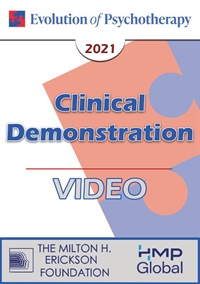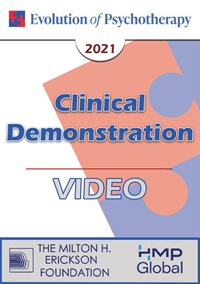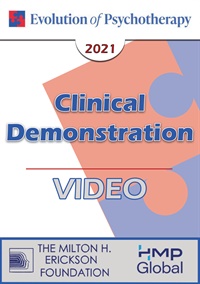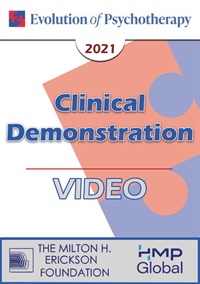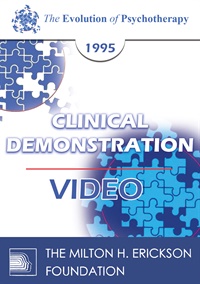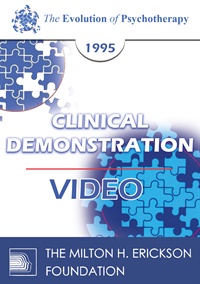- Average Rating:
- Not yet rated
- Topic Areas:
- Clinical Demonstrations | Generative Psychotherapy | Psychotherapy | Art and Creativity
- Categories:
- Evolution of Psychotherapy | Evolution of Psychotherapy 2021
- Faculty:
- Stephen Gilligan, PhD
- Course Levels:
- Master Degree or Higher in Health-Related Field
- Duration:
- 1 hour
- Format:
- Audio and Video
- Original Program Date:
- Dec 02, 2021
- Short Description:
- "This demonstration will show how activating a client's creative process is the key factor in generative psychotherapy. This process follows these steps: (1) Opening a creative safe space (2) Identifying a goal (A positive change or transforming a negative pattern) (3) Identifying and welcoming both obstacles and resources (4) Weaving and integrating the parts into a new "mosaic of self" (5) Orienting to future application of changes. Therapy is successful when clients are able to experientially realize positive life changes. While the identification and transformation of symptoms is important in this regard, the activation of the client's creative capacity to change is even more important. This paper outlines 6 steps in this therapeutic process: (1) opening a mindful field, (2) setting positive intentions, (3) developing and maintaining a creative state, (4) identifying a "storyboard" for achieving goals, (5) transforming negative experiences, and (6) everyday practices. Metho
- Price:
- $59.00 - Base Price
- Average Rating:
- Not yet rated
- Topic Areas:
- Belief Systems | Clinical Demonstrations
- Categories:
- Evolution of Psychotherapy | Evolution of Psychotherapy 2021
- Faculty:
- Robert Dilts, BA
- Course Levels:
- Master Degree or Higher in Health-Related Field
- Duration:
- 1 hour
- Format:
- Audio and Video
- Original Program Date:
- Dec 03, 2021
- Short Description:
- Our beliefs exert a very powerful force on our behavior. Our beliefs about ourselves and what is possible in the world around us greatly impact our capacity for change and healing. Limiting beliefs, or belief barriers, can act like an invisible force that interfere with our capacity to be resourceful and trap us in unhealthy patterns of behavior. Empowering beliefs help us to identify and take best advantage of potential opportunities. This demonstration will show how to identify and transform belief barriers by integrating somatic and emotional intelligence to create an empowering "belief bridge."
- Price:
- $59.00 - Base Price
Tags: Belief Systems
- Average Rating:
- Not yet rated
- Topic Areas:
- Clinical Demonstrations | Experiential Therapy | Psychotherapy
- Categories:
- Evolution of Psychotherapy | Evolution of Psychotherapy 2021
- Faculty:
- Jeffrey Zeig, PhD
- Course Levels:
- Master Degree or Higher in Health-Related Field
- Duration:
- 1 hour
- Format:
- Audio and Video
- Original Program Date:
- Dec 03, 2021
- Short Description:
- Hypnotic psychotherapy uses both formal trance and methods derived from hypnosis.
- Price:
- $59.00 - Base Price
- Average Rating:
- Not yet rated
- Topic Areas:
- Clinical Demonstrations | Emotionally Focused Therapy (EFT) | Psychotherapy
- Categories:
- Evolution of Psychotherapy | Evolution of Psychotherapy 2021
- Faculty:
- Sue Johnson, EdD
- Course Levels:
- Master Degree or Higher in Health-Related Field
- Duration:
- 1 hour
- Format:
- Audio and Video
- Original Program Date:
- Dec 03, 2021
- Short Description:
- EFIT expands the clients sense of self and emotional balance. This session will show key moves in the EFIT Tango - the key intervention sequence in EFIT. This intervention shapes corrective emotional experiences that prime secure connection with both self and others.
- Price:
- $59.00 - Base Price
- Average Rating:
- Not yet rated
- Topic Areas:
- Clinical Demonstrations | Psychotherapy
- Categories:
- Evolution of Psychotherapy | Evolution of Psychotherapy 1995
- Faculty:
- Jeffrey Zeig, PhD
- Course Levels:
- Master Degree or Higher in Health-Related Field
- Duration:
- 55:40
- Format:
- Audio and Video
- Original Program Date:
- Dec 15, 1995
- Short Description:
- Educational Objectives: To describe the method of "orienting toward." Given a patient, demonstrate appropriate use of the technique of guiding associations.
- Price:
- $59.00 - Base Price
Tags: Jeff Zeig Psychotherapy

- Average Rating:
- Not yet rated
- Topic Areas:
- Clinical Demonstrations | Psychotherapy | Supervision
- Categories:
- Evolution of Psychotherapy | Evolution of Psychotherapy 1995
- Faculty:
- Otto Kernberg, MD
- Duration:
- 54:08
- Format:
- Audio Only
- Original Program Date:
- Dec 15, 1995
- Short Description:
- Clinical Demonstration 03 from the Evolution of Psychotherapy 1995 - Supervision of a Psychodynamic Psychotherapy
- Price:
- $15.00 - Base Price

- Average Rating:
- Not yet rated
- Topic Areas:
- Clinical Demonstrations | Hypnotherapy | Interviewing | Psychotherapy | Art and Creativity
- Categories:
- Evolution of Psychotherapy | Evolution of Psychotherapy 1995
- Faculty:
- Ernest Rossi, PhD
- Duration:
- 57 Minutes
- Format:
- Audio Only
- Original Program Date:
- Dec 15, 1995
- Short Description:
- Educational Objectives: To describe the three-step Basic Accessing Question to facilitate reactive reorganization of the problem. To demonstrate two variations of the Basic Accessing Question in Depth Psychotherapy.
- Price:
- $15.00 - Base Price
- Average Rating:
- Not yet rated
- Topic Areas:
- Clinical Demonstrations | Brief Therapy | Dreamwork | Psychotherapy
- Categories:
- Evolution of Psychotherapy | Evolution of Psychotherapy 1995
- Faculty:
- James Hillman, PhD
- Course Levels:
- Master Degree or Higher in Health-Related Field
- Duration:
- 57:49
- Format:
- Audio and Video
- Original Program Date:
- Dec 15, 1995
- Short Description:
- Educational Objectives: To list three reasons for working with dreams in the initial interview and in brief psychotherapy. Given patients with no dreaming, list techniques for eliciting dreams and for "dream substitutes."
- Price:
-
Sale is $29.00
price reduced from Base Price - $59.00

- Average Rating:
- Not yet rated
- Topic Areas:
- Clinical Demonstrations | Gestalt | Supervision
- Categories:
- Evolution of Psychotherapy | Evolution of Psychotherapy 1995
- Faculty:
- Miriam Polster
- Duration:
- 56 Minutes
- Format:
- Audio Only
- Original Program Date:
- Dec 15, 1995
- Short Description:
- Clinical Demonstration 09 from the Evolution of Psychotherapy 1995 - Supervision in Gestalt Therapy, featuring Miriam Polster, PhD. Educational Objectives: To demonstrate how gestalt therapy principles may apply in a supervision session. To explore how the characteristics of the supervisee may influence and enrich his/her therapeutic style.
- Price:
- $15.00 - Base Price

- Average Rating:
- Not yet rated
- Topic Areas:
- Clinical Demonstrations | Psychotherapy | Therapist Development
- Categories:
- Evolution of Psychotherapy | Evolution of Psychotherapy 1995
- Faculty:
- Erving Polster, PhD
- Duration:
- 53 Minutes
- Format:
- Audio Only
- Original Program Date:
- Dec 15, 1995
- Short Description:
- Clinical Demonstration 11 from the Evolution of Psychotherapy 1995 - Humanization of Technique, featuring Erving Polster, PhD. Educational Objectives: To describe and illustrate the difference between ordinary human engagement in therapy and technical engagement. To describe a moment when you could discern a felt meeting of minds between patient and therapist.
- Price:
- $15.00 - Base Price
Please wait ...


